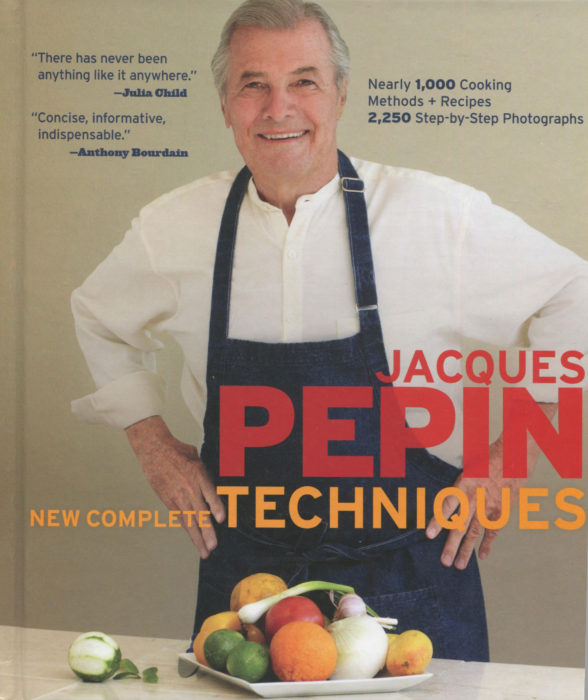
Sometimes a good thing simply gets better. Jacques Pepin created spectacular books in the 1970s, La Technique and La Methode. There were recipes there, to be sure, but the core of those heavily illustrated books — hundreds of black-and-white photographs — was the presentation of the discipline of cooking. How to do things: how to cut up a chicken for a stew, how to prepare an octopus, how to pipe a chocolate meringue cake. In the 1980s, Jacque took a revised look with the two-volume set The Art of Cooking, peppered now with color photographs.
Finally, in 2012, Jacques combined all those books into this one master volume: Jacque Pepin New Complete Techniques. Yes, I delayed getting my copy, because I was happy with those older volumes on my bookshelf. But, I kept looking and looking at the new one and now I have succumbed. It saves space. Some space.
This volume is hardly slim: over 700 pages, almost 1,000 illustrated recipes and techniques and, of course, over 2,200 of those now famous step-by-step photographs. How do you describe this book? There is the perfect cover quote from Julia Child: “There has never been anything like it anywhere.”
There are a dozen chapters covering culinary basics, the standard types of dishes, the key skills and how to present your creations for the table:
- Equipment
- Basics, Sauces and Stocks
- Vegetables
- Eggs
- Fish and Shellfish
- Poultry
- Meat
- Offal and Charcuterie
- Carving
- Bread and Pasta
- Pastry and Dessert
- Presentation
Think of this book as Masters in Culinary Science. You could work your way through the 700 pages in a few months. A few pages a day, a few moments a day, to study, reflect and probably smile. “So that’s how you carve a poached salmon?” is an expression sure to flow from your mouth.
If you are foodie, you’ve seen things that you appreciated: those charming ridges baked into a loaf of bread, cream puff swans, flowers made of butter, a tomato carved into a rose. You’ve appreciated, but you’ve had no idea how to do it. Now, in a few pages, in several photos, you realize you can fashion those fantasies at home, any time, any day, any meal.
I know. You plan on skipping that chapter on Offal and Charcuterie. Not so fast. You may well skip over the brains and the rolled headcheese and stuffed pig’s feet. You might, though, want to consider the Pistachio Sausage in Brioche with Mushroom Sauce. Or the Cold Parsleyed Ham. There is a reason French food and techniques are so admired. The balance of ingredients and flavors, the careful arrangement of steps to prepare elements and then combine them, the exploitation of all the tools in a fully-equipped kitchen — all those factor in the rise and dominance of French cuisine.
That’s surely the power of the photos for they show how to use the most important piece of kitchen equipment: your hands. Your hands. How often have you stood in front of something on your countertop and wondered where to begin? How to use string to wrap up that pork loin or that chicken? How to hold a knife when getting kernels off an ear of corn? How to hold and move the pan while making a crêpe?
This is book to sample at will. Cooking a chicken? There are 20 entries and 50 page citations. If you need to eviscerate your bird, you’ll see how. If it’s mere carving, there are pictures to make you seem like a third-generation butcher. You may not be able to spend a year or two at cooking school in Paris. That would be a grand experience. So is this eternal book.
